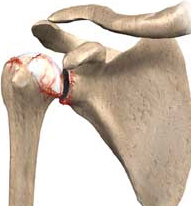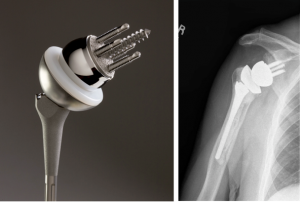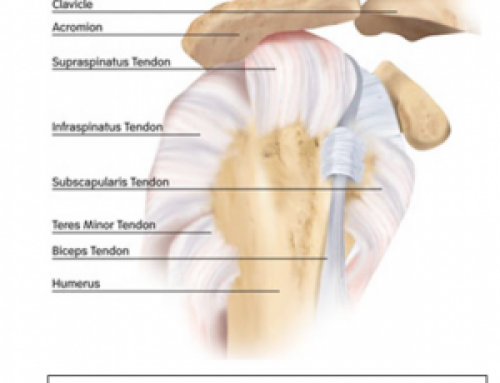by SPORTSDOC RAJ
Reverse total shoulder replacement is a surgical procedure designed specifically for a condition known as rotator cuff tear arthropathy (joint disease). Rotator cuff tear arthropathy occurs when an individual suffers from both a rotator cuff tear and arthritis of the shoulder.
Each shoulder has a rotator cuff tendon which is a compilation of 4 muscles coming together. It is critical in the performance of certain shoulder functions like lifting the arm over the head as well as centering the ball within the socket of the shoulder joint. If one or both of the rotator cuffs sustains a tear, the  shoulder can degenerate and develop arthritis.
shoulder can degenerate and develop arthritis.
When a traditional shoulder replacement surgery is performed, the affected humerus ball is removed and replaced with an artificial ball made of metal (stainless steel, titanium, or other). Then, the arthritic shoulder blade socket is replaced with a man-made socket (plastic). If a shoulder patient also has a torn rotator cuff, the issue is that it doesn’t help considerably with helping a patient lift the arm. It does help considerably with the pain.
Reverse Total Shoulder Replacement
The reverse total shoulder replacement surgical technique was developed because other types of surgical procedures, mainly used for cases of shoulder arthritis, are not particularly successful when a rotator cuff tear is also present. While a reverse total shoulder replacement also utilizes a ball-and-socket type of joint technology, the ball is positioned on the shoulder blade, and the socket is put on the top of the humerus. Since, this is actually the complete reverse of normal human anatomy, the procedure is referred to as a “reverse total shoulder replacement.”
 Los Angeles orthopedic surgeons do not want to recreate “normal” human anatomy in the case of patients who do not have normal functioning rotator cuffs. Thus, this type of shoulder replacement surgery is an excellent choice for tackling this particularly complicated shoulder condition.
Los Angeles orthopedic surgeons do not want to recreate “normal” human anatomy in the case of patients who do not have normal functioning rotator cuffs. Thus, this type of shoulder replacement surgery is an excellent choice for tackling this particularly complicated shoulder condition.
This replacement surgery gives the large shoulder muscle (deltoid) additional efficiency since the rotator cuff does not function effectively in patients with rotator cuff tear arthropathy. Therefore, the deltoid muscle can make up for the defective rotator cuff. With the ball and the socket in reversed positions, the deltoid muscle is better able to lift the arm overhead thus compensating for the torn rotator cuff.
While this type of surgery has been performed for well over ten years in parts of Europe, it was only approved by the FDA in 2004. Even though there has been quite promising data released on the use of these implants, the procedure is still considered to be a fairly new surgical technique. So, it is felt that additional research is necessary.
Indications for a Reverse Total Shoulder Replacement
A reverse total shoulder replacement should only be considered if non-surgical treatment options have failed to effectively address symptoms. Patients should definitely question their orthopedic surgeon in Beverly Hills and Los Angeles concerning how much experience they have with this relatively new technique. As mentioned, good surgical candidates for reverse total shoulder replacement surgery must suffer from both a chronic rotator cuff tear and severe shoulder  arthritis. Patients without this specific combination of shoulder conditions can generally undergo other more traditional surgical options.
arthritis. Patients without this specific combination of shoulder conditions can generally undergo other more traditional surgical options.
Other factors that must be taken into consideration include the prospective surgical candidate’s age, optimal deltoid muscle functioning and the patient’s overall demands from an overall functioning standpoint.




